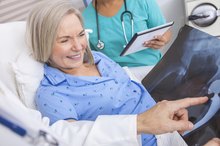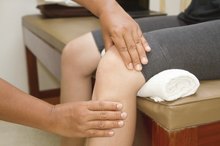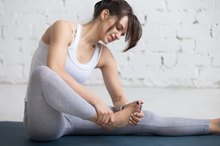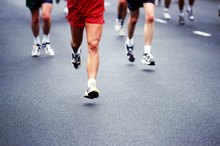Exercises for Knee Rehabilitation After ACL Surgery
Anterior cruciate ligament, or ACL, injuries affect hundreds of thousands of people in the U.S. every year. Because this ligament is key to the stability of your knee joint, surgery is frequently required to repair severe ACL tears. After surgery, rehabilitation exercises strengthen your muscles and are grouped into phases. The time frame for each phase depends on the material used to rebuild the torn ligament and your doctor's input.
Phase One
Knee exercises typically begin within a week after surgery, under the direction of a physical therapist. Range of motion exercises are performed to increase bending capacity at your knee joint. This movement is often difficult after ACL surgery, as your leg may be in a brace with your knee held in a straight position most of the time for several weeks. Generally, the goal is to bend your knee to 90 degrees by 4 weeks after surgery. If your knee does not fully straighten, exercises will be added to address this as well. Early knee exercises also focus on strengthening your quadriceps muscles, the large muscles running along the front of your thigh. This muscle group is key to safe walking and is weak immediately after surgery. Quadriceps-strengthening exercises are performed while sitting or lying down to avoid putting weight on your leg.
- Knee exercises typically begin within a week after surgery, under the direction of a physical therapist.
- This movement is often difficult after ACL surgery, as your leg may be in a brace with your knee held in a straight position most of the time for several weeks.
Phase Two
Exercise After Hip Replacement
Learn More
Phase two exercises typically begin between 4 to 6 weeks after surgery. Knee exercises are performed in a standing position. Resistance bands and ankle cuff weights are often used to add resistance to your knee-strengthening exercises. Range of motion exercises are continued to achieve as much knee flexibility in bending as is possible. Stationary biking is common, improving endurance and increasing mobility in your knee joint. Balance exercises, such as standing on one foot, are also incorporated in this phase.
- Phase two exercises typically begin between 4 to 6 weeks after surgery.
- Resistance bands and ankle cuff weights are often used to add resistance to your knee-strengthening exercises.
Phase Three
Phase two exercises often continue into phase three, progressing the resistance to make the exercises more challenging. This phase typically begins around 8 weeks after surgery. Other exercise machines, such as a stair stepper or elliptical machine, are often introduced at this point in your rehabilitation. Knee exercises also include squats, leg press and step-ups, gradually increasing the height of the step. Pool running and swimming may be added as well.
- Phase two exercises often continue into phase three, progressing the resistance to make the exercises more challenging.
- Knee exercises also include squats, leg press and step-ups, gradually increasing the height of the step.
Phase Four
Hip ORIF Rehab Exercises
Learn More
The final phase of knee rehabilitation exercises following ACL repair begins somewhere between 4 to 6 months after surgery. During this phase, knee exercises include jumping, sprinting and other sport-specific, high-speed movements. Your surgeon may delay pivoting exercises until 6 to 9 months after surgery to decrease risk of reinjury. You may also need to temporarily or permanently wear a custom knee brace during sports activities to further protect your repaired ligament from reinjury.
- The final phase of knee rehabilitation exercises following ACL repair begins somewhere between 4 to 6 months after surgery.
- Your surgeon may delay pivoting exercises until 6 to 9 months after surgery to decrease risk of reinjury.
Related Articles
References
- The Journal of Bone and Joint Surgery: Rehabilitation After Anterior Cruciate Ligament Reconstruction
- International Journal of Sports Physical Therapy: The Role and Implementation of Eccentric Training in Athletic Rehabilitation -- Tendinopathy, Hamstring Strains, and ACL Reconstruction
- Clinics in Sports Medicine: Current Status and Potential for Primary ACL Repair
- Clinical Orthopaedics and Related Research: Effects of a Knee Extension Constraint Brace on Lower Extremity Movements After ACL Reconstruction
- Cavanaugh J, Powers M. ACL rehabilitation progression: where are we now?. Curr Rev Musculoskelet Med. 2017;10(3):289-296. doi:10.1007/s12178-017-9426-3
- Hauger A, Reiman M, Bjordal J, Sheets C, Ledbetter L, Goode A. Neuromuscular electrical stimulation is effective in strengthening the quadriceps muscle after anterior cruciate ligament surgery. Knee Surg Sports Traumatol Arthrosc. 2018;26(2):399-410. doi:10.1007/s00167-017-4669-5
- UW Health. Rehabilitation guide. Updated 2015.
- Rach BR, Provencher MT. ACL surgery: How to get it right the first time and what to do if it fails. 2010.
- Bousquet B, O'brien L, Singleton S, Beggs M. Post-operative criterion based rehabilitation of acl repairs: a clinical commentary. Int J Sports Phys Ther. 2018;13(2):293-305.
- Beischer S, Hamrin Senorski E, Thomeé C, Samuelsson K, Thomeé R. Knee strength, hop performance and self-efficacy at 4 months are associated with symmetrical knee muscle function in young athletes 1 year after an anterior cruciate ligament reconstruction. BMJ Open Sport Exerc Med. 2019;5(1):e000504. doi:10.1136/bmjsem-2018-000504
Writer Bio
Aubrey Bailey has been writing health-related articles since 2009. Her articles have appeared in ADVANCE for Physical Therapy & Rehab Medicine. She holds a Bachelor of Science in physical therapy and Bachelor of Arts in psychology from the University at Buffalo, as well as a post-professional Doctor of Physical Therapy from Utica College. Dr. Bailey is also a certified hand therapist.









